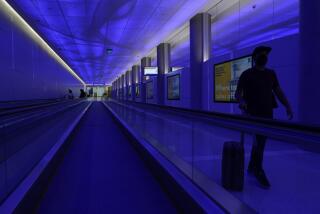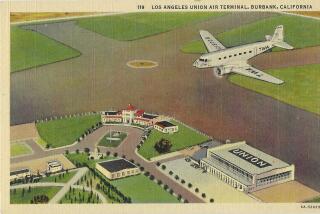Friendly Skies Rough for the Smaller Airlines
Shortly before 7 o’clock last Sunday evening a dark blue DC-9 roared down the runway at LAX. Four hours later, after a stop in San Antonio, Transtar flight 552 landed at Houston’s Hobby Airport.
The plane taxied to its assigned gate, the door opened and its passengers deplaned. Then the door was locked. The plane was quietly towed away and parked next to 14 other locked aircraft.
Flight 552 was the last for Transtar airlines, which ceased operations and closed forever on Aug. 9.
“We’re not insolvent, and we’re not bankrupt,” says Transtar spokesman Ted Standfest. “We just didn’t see any light at the end of the tunnel.”
Transtar is just the latest in a series of small “boutique” airlines that have failed.
In an era of mergers, acquisitions and consolidations, the plight of many good, small airlines is very much in doubt.
Struggled to Compete
Air Atlanta, an innovative airline that prided itself (justifiably) on comfort and good service, ran into money problems earlier this year. The small, privately held carrier was started in February, 1984, with only a few airplanes. For the next three years it struggled to compete against major carriers on heavily traveled routes between Atlanta and New York and Washington, D.C.
Air Atlanta soon became popular with businessmen who liked the carrier’s schedule and food service. Air Atlanta also catered to business fliers with free newspapers and coffee in waiting lounges. And, an Air Atlanta innovation was the movable garment rack.
The invention was instrumental in reducing passenger congestion during boarding and after the airplane landed. Passengers boarding Air Atlanta flights would hang their garment bags on a rack stationed outside the jetway. The rack would be the final item taken onto the plane after all the passengers were on board. It would be the first item taken off after landing.
But as successful as the airline was with passengers, it wasn’t making any money. If it lowered its fares to encourage new passengers, its competitors matched those fares.
By March of this year Air Atlanta was flying only seven 727 jets and in dire need of cash. The airline failed shortly thereafter.
Other small airlines to fail this year include McClain Airlines, which tried to operate all first-class service between Los Angeles and Chicago (using only three 727s) and Royal West airlines, which flew between Reno, Los Angeles, Burbank and Ontario and failed in March (it also only operated three aircraft).
Presidential Airlines, which tried to establish itself at Dulles Airport in Washington, D.C., as a low-fare carrier using 737 jets, is now a small feeder airline for Continental.
And the new Braniff, which resumed reduced operations in March, 1984 (after filing for Chapter 11 protection in 1982), has sustained large operating losses in its struggle to make a profit.
Only a few of the small airlines have survived, and even fewer--Midway, Southwest and America West--have prospered.
But in cases where small low-cost airlines have failed or were restructured, fares in markets where those airlines competed against larger carriers suddenly went up.
“It’s a simple and painful case of the law of supply and demand,” says one airline official who prefers anonymity. “The consumer will lose every time an airline merges with another or fails.”
How? For example, take the Minneapolis market. Before Northwest acquired Republic Airlines, the two carriers slugged it out on many of the same routes. Fare wars often erupted, and smart passengers could often get good bargains on their airline tickets.
Since the acquisition, Northwest dominates the Minneapolis market and many air fares have risen.
In a market where a competing carrier simply fails, the resulting rise in ticket prices can be substantial.
A good example of this may very well be the demise of Transtar. You might remember Transtar when it was Muse Air, a colorful, upstart airline started six years ago by Lamar Muse, a former Southwest Airlines executive. Initially, Muse flew to Houston, Dallas, Los Angeles and New Orleans. Muse soon started controversial marketing campaigns. One offered a “satisfaction or money back” guarantee. Another banned smoking completely on Muse flights.
Both ideas met with limited success. When other airlines didn’t match the no-smoking policy, Muse had to cancel the smoking ban because it had lost too many smokers to other carriers.
Two years ago, after suffering continuing losses, Muse was acquired by its chief competitor, Southwest, for $60 million. Southwest then renamed the airline Transtar, and moved it from Dallas to Houston. The move to Houston, and cutthroat competition with Continental, was too much for Transtar to handle.
It soon resorted to desperation pricing. To attract passengers to fly Transtar from Hobby Airport to Los Angeles, the airline promoted $79, totally unrestricted “go” fares last year. Transtar also equipped its planes with all-leather seats, airphones, and good, nutritious meals.
The fares proved so popular that by October Transtar boasted the highest “load factor” in the airline industry.
But it wasn’t long before Continental, which used to fly only out of Houston’s larger Intercontinental Airport, not only matched the fares, but moved some of its planes to Hobby to compete one-on-one.
Continental also reduced its first-class fares. In some instances the Continental first- class fare out of Hobby Airport was less than Continental’s coach fare for the same route leaving out of Houston’s Intercontinental Airport.
‘Tough Lesson’
“It was a tough lesson,” says Transtar’s Standfest. “We could fill the airplanes with cheap fares, but you can’t make any money.”
With the elimination of a low-cost airline, consumers lose, too. Airline analysts predict that air fares once again will rise. Continental Airlines has already announced that it will honor Transtar tickets already issued, but will charge passengers the difference between the Transtar fare and the current Continental fare.
And now the cheapest one-way, unrestricted ticket between Houston and Los Angeles is $248. A restricted $147 fare is available, but seats are limited. Ironically, that was the same unrestricted fare once quoted by Transtar for every seat.
More to Read
Inside the business of entertainment
The Wide Shot brings you news, analysis and insights on everything from streaming wars to production — and what it all means for the future.
You may occasionally receive promotional content from the Los Angeles Times.










